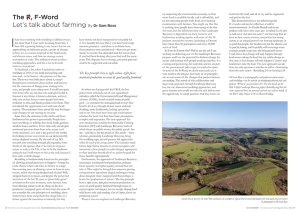
I have been working with rewilding in different ways for more than 5 years now. Learning from this, I have felt a growing feeling in my bones that we are approaching an inflection point, a point of change in how we as a nation respond to the biodiversity and climate crises, and how we manage nature restoration at scale. This inflection point involves rewilding approaches, and has a lot to do with farmers, so read on!
To backtrack a bit, when I started my work on rewilding in 2019, it was bold and exciting and new and—to be honest—the preserve of the very few. There was very little press about it, except disingenuous comments about wolves and beavers, but the successes of Knepp were starting to be seen, and people were taking note. I would not agree with those who say only those who could afford it, did it, because it was always a business decision, and very risky one at that, but yes some people had more resilience to risk, and thank goodness for them. They considered the opportunity cost and went ahead anyway. These pioneers have paved the way for larger scale changes we are starting to see now.
Since then, the attention in the media and from landowners has grown exponentially. People have been rewilding, or wilding, their land, fields, gardens, window boxes and lives. It has taken off, and despite continued pressure from those who accuse it of ‘woke nonsense’, it is now a key part of our toolkit for helping restore ecosystems in our demonstrably nature-depleted country. By the end of my MA research into rewilding through photography, I was firmly of the opinion that if we want to improve nature at scale in the UK, it has to be the landowners taking the lead. I will return to this at the end, because I have seen a subtle change.
Rewilding is fundamentally based on the principles of allowing natural processes to happen—letting the cattle choose where and what to browse in a large free-roaming area, or allowing a river to form its own course, rather than being dredged and cleared. Well, stripped back to its basics, and despite the policy-led incentives of the last 50 years to ‘grow-baby-grow’ at whatever the costs to nature, some farmers have been allowing nature to do its thing on the less-productive (marginal) parts of their farm for years. If you consider the core principles of rewilding, these farmers have been using them for a long time, as a choice against the incentives to intensify, but they have mostly not been recognised or rewarded for it. It is broadly the case that if you have been using intensive practices—and there is no blame here, these practices were incentivised—then you get more money to restore that degraded land for nature than if you had been looking after your land well for many years. This disparity has to change, and good practices need to be supported and rewarded.
So where am I going with this? Well, the last government initiated a set of new agricultural subsidies called the Environmental Land Management schemes (ELMs), based on public money for public goods—i.e. payment for managing land in ways that benefit all of us, through cleaner water, reduced flooding, more biodiversity, locking up carbon and so on. Yes there have been agri-environment schemes for years, but they have been prescriptive, complex and unpopular.
The new approach has new mechanisms, notably the Sustainable Farming Incentive (SFI) and Landscape Recovery, both of which focus on public money for public goods. For me—and this is the key point of this article—these schemes, particularly Landscape Recovery, bring the rewilding-type, natural-process led approaches within the reach of the average farmer. This includes small farms, large farms, tenants or owner-occupiers, and incentivises these people to make changes appropriate to their land that benefit all of us and to be paid for those benefits appropriately.
Furthermore, the approach of Landscape Recovery encourages continued food production, perhaps lower quantity but higher quality, on land that can take it. This might be through less intensive grazing, or regenerative agriculture (regen) techniques being done alongside more marginal land that perhaps is better for ‘production of nature’. The key principle here is right action, right place; maintain production on areas of good quality farmland through regen or regen/organic techniques, but on steeply sloping land with heavy soils and needing a lot of input, focus on producing nature.
There is also an emphasis in Landscape Recovery on improving the rural circular economy, so that more food is available locally and is affordable, and on reconnecting people with food, non-farming communities with farmers. You might say that this is nothing new, people have been trying to do this for years, but the difference here is that Landscape Recovery is dependent on many farmers and landowners working together, and some of the 56 projects around the country (including in Dorset) have more than 50 participants and over 10,000 acres of land.
So how do I know this? Well in my day job I am working on delivering one of the Landscape Recovery projects and I see the potential for holistic change for nature and farming with people working together. It is exciting and pioneering, but untested, and we are part of the government’s pilot stage, so watch this space. In term of the R-Word, we don’t necessarily use it very much in the project, but many of its principles are set into some of the changes that partner farmers are making. The arrival of this collaborative and large-scale approach through Landscape Recovery has, for me, democratised rewilding approaches, and given farmers who could not take the risk before now the opportunity to adopt practices that they know are better for the land, and all of us, and be supported and paid to do that.
This democratisation is my inflection point. If it works and can be rolled out, it will be transformational. As Charlie Burrell said in my podcast with him a few years ago “everybody has the right to walk out of their door into nature”, not meaning that we have to have nature reserves everywhere but seeing nature as an integral part of our farming landscape. It is good for people, for biodiversity, for the climate and its good for farming, and hopefully will encourage more younger people to get into the beleaguered sector. I said above that change will only happen through landowners taking the lead, but my subtle change to that now is that change will only happen if farmers and landowners take the lead. This new approach can do that, my only question is whether to call it—borrowing from the tech sector—Rewilding 2.0 or Farming 2.0?
Dr Sam Rose is a photographer and podcaster about nature and rewilding—see his website at whatifyoujustleaveit.info and podcast “What if you just leave it?”. He also heads up the Brit Valley Landscape Recovery project (britvalley.org) but the views expressed here are personal and are not said on behalf of the Brit Valley Project or West Dorset Wilding.




